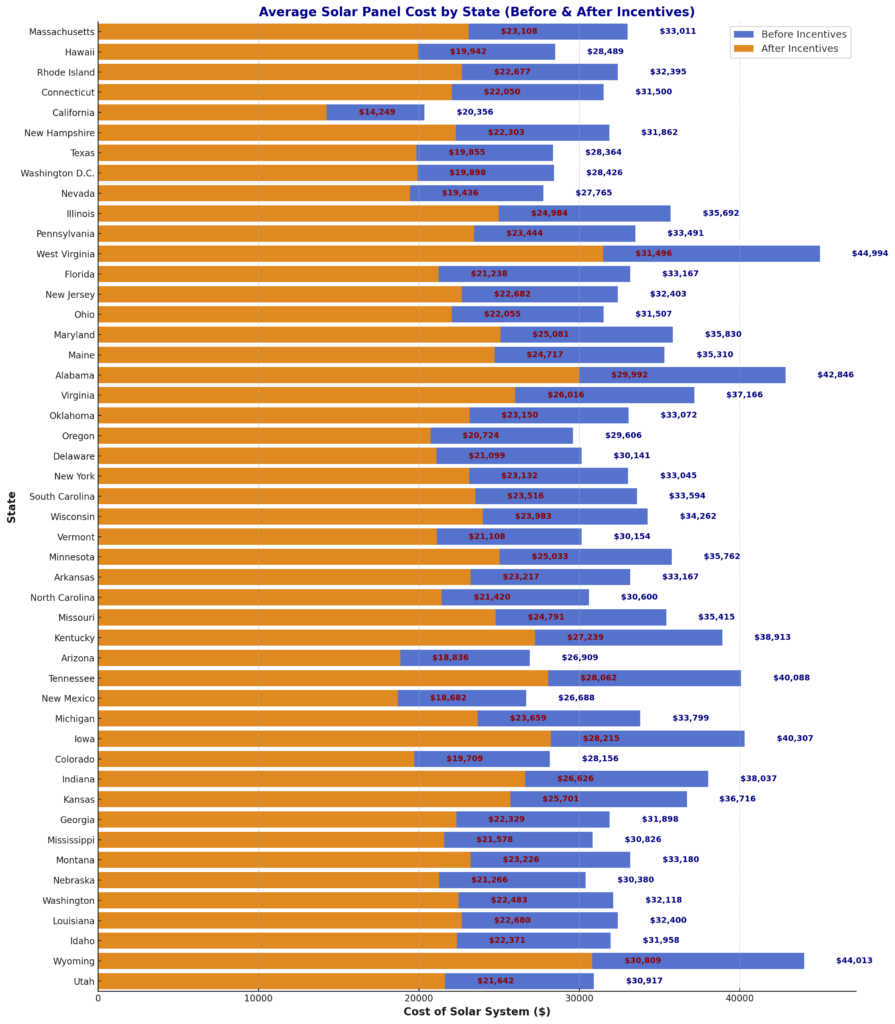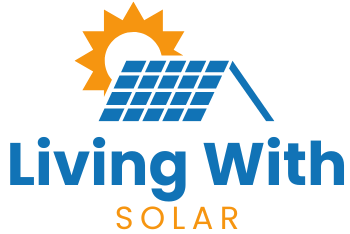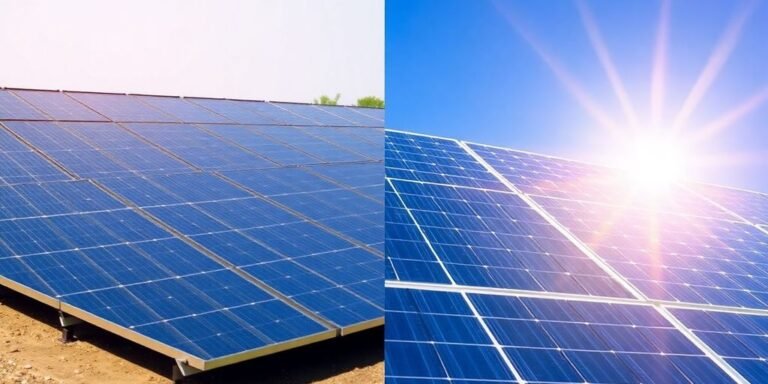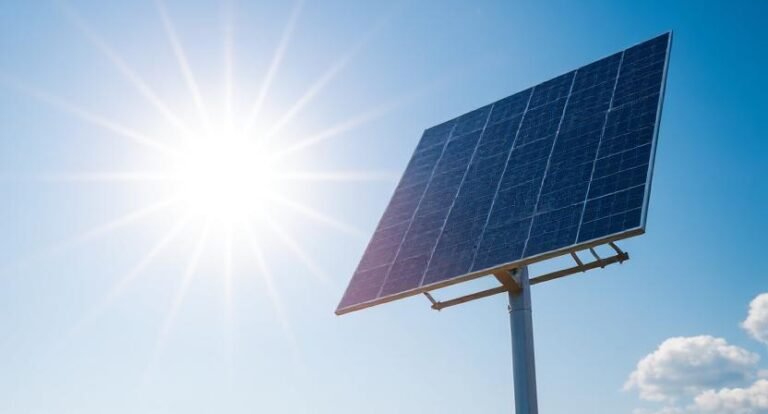Hi, I’m Sophia Green. I write and advocate for solar energy. I’m passionate about making solar power easy and accessible.
Thinking about solar panels? Costs vary a lot based on your location in the U.S. Some states provide great incentives, which make solar more affordable. But in other states, installation costs are higher. Factors like local policies, electricity rates, and sunlight availability all play a role.
This guide shows solar panel costs by state. I’ll explain why prices vary and where to find the best deals. Let’s dive in and see how your state compares!
Key Takeaways
- Solar panel costs differ significantly from state to state in the USA.
- Federal and state incentives can greatly reduce the overall cost of solar panels.
- High-cost states for solar panels often have higher electricity rates.
- Affordable states for solar installation usually offer better incentives and rebates.
- Understanding long-term savings and return on investment is crucial when considering solar panels.
Understanding Solar Panel Costs Across the USA
Factors Influencing Solar Panel Prices
Solar panel prices can vary based on several key factors. The type of solar panels you choose plays a significant role. High-efficiency panels, though pricier, might be worth the investment if you have limited roof space.
Then there’s the size of the system. Larger systems cost more upfront but can save more over time. Installation costs differ too, depending on the company and the complexity of your roof.
Let’s not forget about additional equipment like batteries, which can add to the overall cost.
Regional Variations in Solar Costs
Solar costs aren’t uniform across the country. States with more sunshine, like Arizona, often have lower costs per watt due to higher demand and more competition among installers.
On the other hand, states with less solar adoption might see higher costs. Local electricity prices also impact how cost-effective solar panels are.
For instance, in areas where electricity is expensive, solar panels can offer significant savings, making them more appealing despite higher initial costs.
Impact of Federal and State Incentives
Incentives can greatly affect the cost of solar panels. The federal solar tax credit is a major one, reducing the cost by 26% for systems installed before 2023. Many states offer additional incentives, like rebates or tax credits, which can lower costs further.
These incentives can make solar panels a financially smart choice, even in states where installation costs are high. Over time, these savings can really add up, making solar energy not just an eco-friendly option, but a budget-friendly one too.
Comparing Solar Panel Costs in Different States

High-Cost States for Solar Panels
Some states in the U.S. have notably higher solar panel costs, and understanding why can be crucial if you’re planning to install solar. Hawaii, for instance, often tops the list due to its remote location and high shipping costs for materials. Similarly, states like Alaska face logistical challenges that drive up prices. On the mainland, states such as Massachusetts and New York also see higher costs, partly due to higher demand and local regulations. These states often have higher installation costs as well, which can add to the overall expense.
In high-cost states, investing in solar panels might seem daunting, but the long-term savings and environmental benefits can outweigh the initial expenditure.
Affordable States for Solar Installation
On the flip side, some states offer more affordable options for solar installations. Florida and Texas are known for their competitive pricing, thanks to abundant sunshine and favorable state policies. In these states, the cost per watt can be significantly lower, making solar a more accessible option for homeowners.
Additionally, states like Nevada and Arizona benefit from large-scale solar farms that help reduce costs for individual installations.
State-by-State Cost Analysis
Here’s a quick look at the average solar system costs across different states:

These figures highlight the variations in solar panel costs, influenced by factors like state incentives, local labor costs, and the availability of solar resources. Choosing the right state for your solar installation can significantly impact your overall investment and savings.
When considering solar, it’s essential to weigh these costs against your potential savings on energy bills and the environmental impact of reducing reliance on fossil fuels.
The Role of Incentives in Solar Panel Costs
Federal Tax Credits and Their Impact
The federal solar tax credit, known as the Investment Tax Credit (ITC), is a game-changer for homeowners looking to install solar panels.
It offers a credit worth 30% of the total installation cost on your federal tax bill. This isn’t just a minor perk—it’s a significant reduction in the overall cost of going solar.
For example, if your solar setup costs $30,000, you could receive a tax credit of $9,000. This federal incentive is crucial for making solar energy more accessible and affordable.
State-Specific Solar Incentives
Beyond the federal level, many states have their own incentives to encourage solar adoption. These can include rebates, tax credits, and even performance-based incentives.
States like New York, through programs like NY-Sun Program, offer upfront rebates and tax credits that can drastically reduce the initial costs. Some states also provide net metering, allowing homeowners to earn credits for excess energy their panels produce.
How Incentives Lower Overall Costs
Incentives play a vital role in reducing the upfront and long-term costs of solar installations. They can be the deciding factor for many homeowners contemplating the switch to solar. Here’s how they help:
- Tax Credits: Reduce the overall cost by lowering your tax liability.
- Rebates: Provide immediate financial relief by reducing the upfront installation costs.
- Net Metering: Offers ongoing savings by crediting you for excess energy produced.
In many cases, these incentives make solar panels a feasible option for families who might otherwise find the initial investment too steep. By lowering barriers to entry, incentives not only promote clean energy but also help in achieving broader environmental goals.
Analyzing the Cost-Effectiveness of Solar Panels

Calculating Long-Term Savings
Switching to solar panels can lead to substantial savings on your electricity bill over time. On average, homeowners might save between $31,000 and $100,000 over 25 years.
This isn’t just about cutting costs but making a smart investment in your home’s energy future. The amount you save largely depends on your local electricity rates and the cost of your solar panel system.
To figure out your break-even point, or solar payback period, divide the final cost of your solar system (after incentives) by your annual savings.
Return on Investment for Solar Panels
The return on investment (ROI) for solar panels can be significant. Typically, it takes about 7 years to break even on the initial cost of solar panels. After this period, the energy your panels produce is essentially free, leading to more savings.
It’s important to consider factors like installation costs, maintenance, and any potential increases in electricity costs when calculating ROI. With electricity prices rising, the ROI for solar panels is becoming more attractive.
Cost-Benefit Analysis by State
When looking at the cost-effectiveness of solar panels, it’s crucial to consider regional differences. States with higher electricity rates generally offer more savings. Here’s a simple table to illustrate how costs vary:
| State | Average Cost per Watt | Cost Before Incentives | Cost After Incentives |
|---|---|---|---|
| Wisconsin | $3.10 | $30,992 | $21,694 |
| Wyoming | $3.56 | $29,435 | $20,604 |
While the initial investment might seem high, the long-term benefits of solar panels, including energy independence and environmental impact, make them a worthwhile consideration for many homeowners. It’s not just about the numbers; it’s about a sustainable future.
Trends in Solar Panel Pricing Over Time
Historical Price Trends
Over the past decade, the cost of solar panels has dropped significantly. In the early 2010s, installing solar panels was a hefty investment. Fast forward to today, and the price per watt has decreased by more than 50%.
This drop is largely due to advancements in manufacturing and increased competition among solar companies. Solar technology has become more efficient and affordable, making it a viable option for many homeowners.
Future Predictions for Solar Costs
Looking ahead, solar panel prices are expected to continue their downward trend, albeit at a slower pace.
Technological improvements and economies of scale are likely to drive costs down further. Industry experts predict that by 2030, solar energy could become one of the cheapest sources of power globally.
However, it’s important to note that external factors such as tariffs and supply chain disruptions could impact these predictions.
Technological Advancements and Cost Reductions
The evolution of solar technology is a key factor in reducing costs. Innovations like bifacial panels, which capture sunlight from both sides, and perovskite solar cells, known for their high efficiency and lower production costs, are paving the way for cheaper solar solutions.
Additionally, improvements in energy storage technologies, such as lithium-ion batteries, are enhancing the overall value proposition of solar systems by allowing excess energy to be stored and used during non-sunny periods.
As solar technology continues to advance, the potential for cost savings and energy independence grows, encouraging more homeowners to consider solar installations.
Choosing the Right Solar Panel System for Your State
System Size and Cost Considerations
When you’re thinking about solar panels, the first thing to figure out is the size of the system you need. This depends a lot on your energy use, which can be influenced by your home’s size, the number of people living there, and how much electricity you typically use.
Bigger systems can cost more upfront, but they might save you more in the long run because they generate more power. It’s also worth considering that larger systems often have a lower cost per watt.
Here’s a quick list to help you decide:
- Assess your monthly electricity bill to understand your energy needs.
- Consider potential future changes, like electric vehicles or home expansions.
- Look at your roof space and orientation to see how many panels you can fit.
Selecting Efficient Solar Panels
Choosing the right panels involves more than just picking what’s cheapest. Efficiency is a key factor. More efficient panels generate more electricity from the same amount of sunlight, which can be crucial if your roof space is limited.
While high-efficiency panels might be pricier, they can be worth it if you’re trying to maximize energy production in a small area.
Customizing Solar Solutions for Local Needs
Different states have different climates and sunlight exposure, so it’s important to customize your solar setup accordingly.
For example, in sunnier states, you might prioritize systems that can handle high temperatures without losing efficiency, while in cloudier regions, you might focus on panels that perform well in low-light conditions.
Understanding your local environment is key to maximizing your solar investment. Take into account factors like local weather patterns and any shading from nearby trees or buildings.
By tailoring your solar panel system to your specific state and personal needs, you can ensure you’re getting the most out of your investment.
Wrapping It Up: Solar Panel Costs Across the U.S.
So, there you have it. Solar panel costs really do vary quite a bit depending on where you live. From sunny California to the chillier climates of Maine, each state has its own price tag for going solar. It’s not just about the panels themselves, but also the local incentives, installation costs, and even the amount of sunshine you get.
While the upfront costs might seem steep, the long-term savings on your electricity bill can be a game-changer. Plus, with federal and state incentives, the initial investment can be a lot more manageable.
If you’re thinking about making the switch, it’s definitely worth doing some homework to see how solar can fit into your budget and energy needs. Who knows, you might just find that it’s the perfect time to harness the power of the sun!
Frequently Asked Questions
What are the main factors that affect solar panel costs?
The cost of solar panels can vary based on several factors, including the brand of the panels, their efficiency, the size of the system, and additional equipment like batteries. Location and installation company pricing can also impact the overall cost.
How do state and federal incentives help reduce solar panel costs?
State and federal incentives, such as tax credits, can significantly lower the cost of installing solar panels. These incentives can reduce the upfront cost by a considerable amount, making solar energy more affordable.
Which states have the highest and lowest solar panel costs?
States like California generally have lower solar panel costs due to high demand and favorable weather conditions, while states like West Virginia and Alabama might have higher costs due to less demand and different weather patterns.
How can I calculate the cost-effectiveness of solar panels for my home?
To calculate cost-effectiveness, consider the initial installation cost, available incentives, and long-term savings on electricity bills. Comparing these factors can help determine if solar panels are a good investment for your home.
What is the average cost of solar panels per watt?
The average cost of solar panels in the U.S. is around $2.56 per watt before incentives. This cost can vary depending on the state and specific installation requirements.
How long does it take to see a return on investment from solar panels?
On average, it takes about 7.1 years to recoup the cost of solar panel installation through savings on electricity bills. This period can vary based on local electricity rates and the cost of the solar system.





